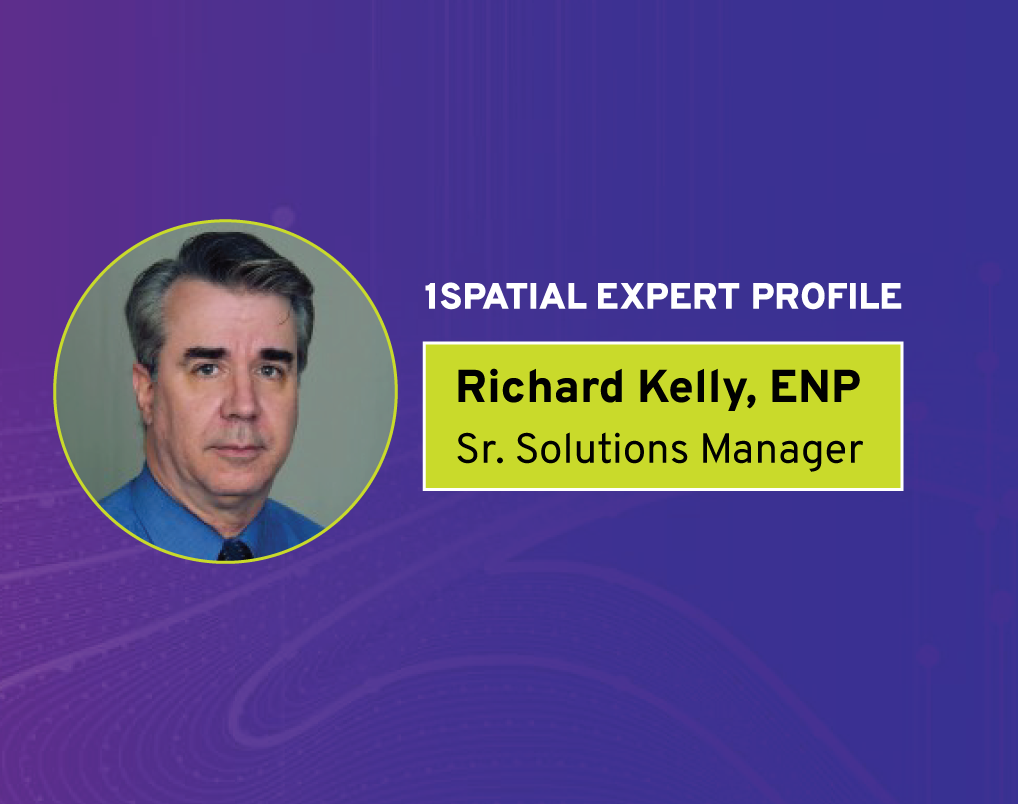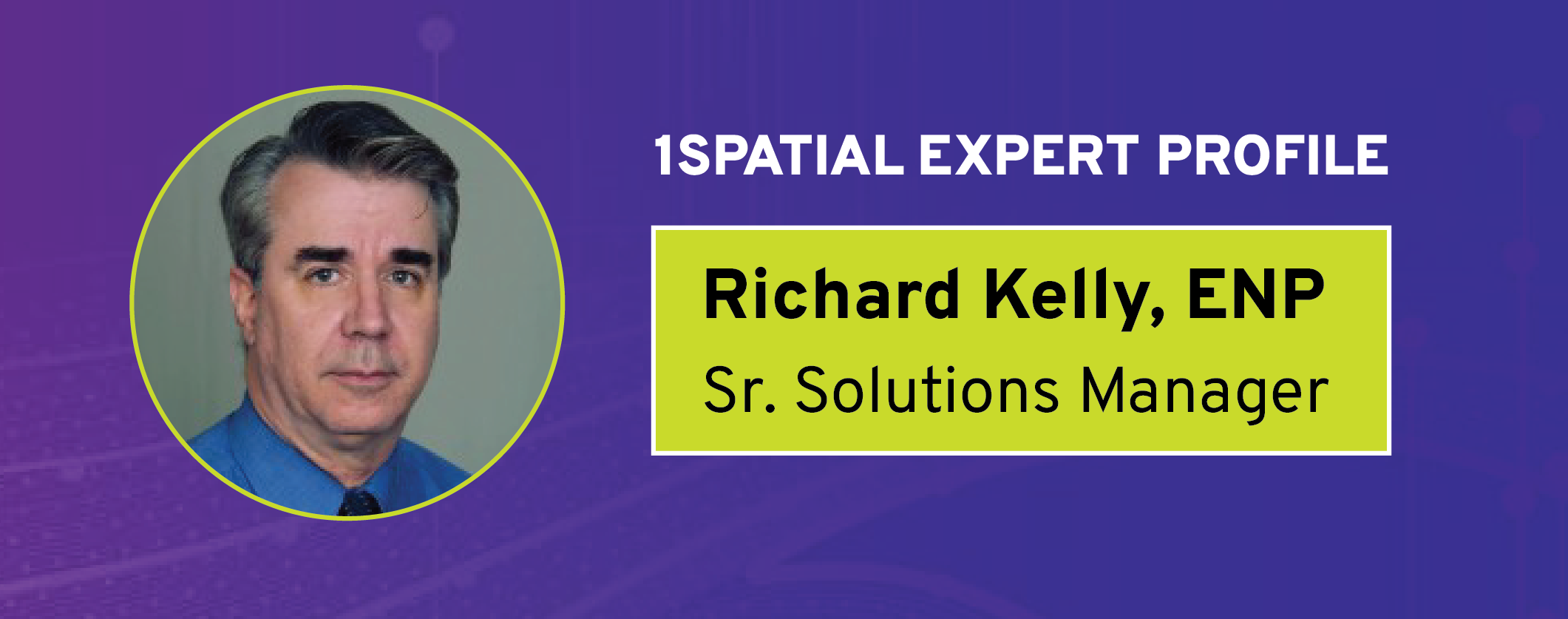Richard Kelly: A Trusted Guide to Next-Gen 9-1-1 GIS Data


A Lifelong Commitment to Public Safety GIS
In the world of public safety and emergency response, few experts can rival the depth and breadth of experience Richard Kelly brings to the table. As the Senior Solutions Manager at 1Spatial, Richard has dedicated over 30 years to advancing Geographic Information Systems (GIS) for 9-1-1 and public safety. Following 10 years of GIS work in the Public Sector, he spent two decades of that tenure in the private sector developing 9-1-1 technologies, where he led and innovated at major industry players.
In that time, he’s worn many hats in the emergency GIS field. Notably, Mr. Kelly led geospatial solutions at 911 Datamaster as Vice President and later served with Motorola Solutions as Director of NGCS (Next Generation Core Services) GIS Advocacy. Colleagues recall how he created entire GIS data validation toolsets and user interfaces from scratch (even down to icon design) on a shoestring budget, evolving a legacy on-premises GIS database management tool into a modern cloud-based Software-as-a-Service (SaaS), multi-agency aggregation and distribution solution as the industry shifted.
Few can claim this full-stack product lifecycle experience, and it means Richard understands both the technical and human factors that make a new system successful. He even holds multiple patents for advancements in 9-1-1 location technology – tangible proof of his drive to innovate for public safety.
Along the way, Mr. Kelly has published technical articles and whitepapers and taken on active leadership roles in national standards bodies like NENA and APCO – the very organizations defining NG9-1-1 data standards. He even earned Texas NENA’s Collaboration Award in 2019 for his work bringing stakeholders together. This rare blend of deep expertise and collaborative spirit makes Richard Kelly uniquely qualified to guide GIS teams through the Next Generation 9‑1‑1 (NG9-1-1) revolution.
His mission throughout has been consistent: leverage location technology to save lives. As Richard sees it, if he can help bring improved capabilities to locate and handle 9-1-1 callers and assets to every center he works with, he will have achieved a major objective in his career.
Bridging the "Old Way" and the "1Spatial Way"
Richard Kelly isn’t just a veteran; he’s an innovator who has helped shape the evolution of Next Generation 9-1-1 technology from the ground up. Talk to anyone who’s worked in 9‑1‑1 GIS as long as Richard, and you’ll hear how dramatically the landscape has changed.
Kelly remembers the “old way” of public safety GIS: siloed, inconsistent datasets maintained in isolation, heavy manual effort to clean and format data, and little insight into why a given record failed to meet a standard.
“In the past, if an address didn’t match or a road centerline was off, you often only found out after the fact – and fixing it was a tedious, one-off project,” he says.
Today, Mr. Kelly is championing what he calls the “1Spatial way.” This modern approach embraces automation, interoperability, and real-time feedback at every step. Instead of waiting on monthly reports or laborious audits, GIS data can be automatically validated against NG9-1-1 standards, with instant diagnostics that pinpoint errors and guide fixes.
Rather than each jurisdiction inventing its own process, 1Spatial’s tools bring everyone onto a unified platform – but one that still respects local control of data. By having lived through the awkward patchwork of legacy 9‑1‑1 systems and now helping introduce streamlined NG9-1-1 solutions, Mr. Kelly offers a bridge between past and future. He intuitively understands the pain points of the old way and is passionate about implementing a better way forward.
“There’s a lot of hesitation out there, because change is hard,” Mr. Kelly notes. “But when I show people how much easier and safer the new process can be, you see their eyes light up.”
Leading NG9-1-1 Data Readiness with 1Engage
At 1Spatial, Richard Kelly’s mission is focused on one thing: getting GIS data ready for NG9-1-1. The primary tool for that mission is 1Engage, 1Spatial’s NG9-1-1 data management platform.
Mr. Kelly describes 1Engage as “a cloud-based GIS solution that validates and aggregates data from contributors, stewards, and 911 authorities – providing a single, authoritative dataset accessible via a web browser or directly within Esri ArcGIS Pro.”
In essence, 1Engage replaces the need for each local 911 GIS authority to maintain dozens of separate datasets and manual workflows. “It streamlines emergency response support by eliminating the need for contributors to maintain multiple GIS datasets for different 9‑1‑1 systems,” Mr. Kelly explains. All the puzzle pieces – local address points, road centerlines, boundary layers from various jurisdictions – are validated and then merged into one consistent whole. This means 911 centers, GIS coordinators, and state authorities can all work off the same map with confidence that the data is correct and up-to-date.
Mr. Kelly’s extensive experience across agencies and vendors is reflected in the design of 1Engage. He’s quick to point out what makes it different from other solutions. For one, 1Engage meets users where they already work. A GIS technician can run 1Engage’s validation tools right inside Esri’s ArcGIS Pro software via a convenient add-in.
“That was a game-changer we knew was needed,” Mr. Kelly says. “GIS staff shouldn’t have to jump to a separate system just to check their data.” With 1Engage, errors are flagged in near real-time as the technician edits maps, without ever leaving their familiar GIS environment. This tight integration with Esri’s platform reflects Mr. Kelly’s understanding that usability is critical; if a tool disrupts a team’s daily workflow, it won’t get used.
Another differentiator Mr. Kelly emphasizes is automation. 1Engage can be configured to handle routine data upkeep on its own. “You can even link 1Engage to a live GIS data service so you’re not uploading files for each run,” Mr. Kelly notes, “and schedule validations or provisioning outputs to occur automatically on a set interval.” In practice, this means a county GIS manager could set the system to re-check and publish updated 9‑1‑1 data every night, for example, without any human intervention. Such automation not only saves time but also reduces errors – nothing gets forgotten or delayed because the process runs consistently in the background.
For busy public safety GIS teams that wear many hats, having 1Engage as a tireless assistant handling the grunt work is a huge relief. And because 1Engage is aligned with all the latest NENA NG9-1-1 standards and FCC rules by design, agencies don’t have to scramble to keep up with evolving requirements – the platform updates in step with new standards to ensure continuous compliance.
Richard is particularly enthusiastic about how 1Engage facilitates collaboration among the many players in NG9-1-1 data prep. “NG9-1-1 is a team sport,” he likes to say. Local data contributors (like city or county GIS departments) can use 1Engage to validate and improve their own datasets independently, at their own pace.
Meanwhile, state GIS stewards can use the same platform to aggregate those local contributions into a statewide dataset, checking for edge-matching issues or duplicates across boundaries. If a boundary mismatch between two counties is found, 1Engage can generate a markup report that everyone involved can see and work on together.
This workflow encourages a partnership mindset: instead of finger-pointing over data errors, contributors and 911 authorities are looking at the same dashboard, solving problems cooperatively. Mr. Kelly’s decades in the field taught him that technology alone isn’t enough – you need buy-in from all stakeholders. That’s why he’s proud that 1Engage is as much a collaboration platform as it is a technical tool.
Importantly, Mr. Kelly can back up these claims with real-world results. He often points to the state of Minnesota as a case study in NG9-1-1 data transformation. Before 1Spatial’s involvement, Minnesota had spent four years on NG9-1-1 data prep with only modest progress – “only about 5% of the 74 unique GIS data contributors in the state had progressed further than some basic data validation steps,” Mr. Kelly notes. The process was slow and uneven. But after deploying 1Spatial’s 1Engage solution, the turnaround was dramatic. Within two years, over 90% of Minnesota’s local GIS contributors had completed all required validation phases for their data. Over 80% of the state had every required GIS layer aggregated into the central database, ready for NG9-1-1 dispatch systems. This meant that nearly the entire state’s 9‑1‑1 map data was standardized and quality-assured – an achievement that would have been unimaginable under the old manual approach.
Better still, the data didn’t just sit in a silo; Minnesota was able to share the validated GIS data with its state GIS agency and even repurpose it for other needs like transportation and natural resources. For Richard, outcomes like this underscore why he does what he does. “When you empower people with the right tools and guidance, they can move mountains,” he says with a smile.
An Approachable Mentor Through Major Change
While Richard’s technical credentials are impressive, it’s his personable and grounded demeanor that truly solidifies trust with colleagues and clients alike. Richard strives to connect and work with every person in 9-1-1, regardless of role or experience level, with ongoing education of where 9-1-1 is today. “This can range from elected officials to someone sitting next to me on a plane,” he said.
One of his key personal concerns is that average citizens have no idea about how 9-1-1 technologies are being modernized and improved. “Every chance I have to provide just a glimpse of this changing public service is another important aspect of moving NG9-1-1 forward,” Mr. Kelly said.
His thoughtfulness brings a down-to-earth touch that reminds everyone that at the end of the day, this work is about people and communities. This authenticity helps break down barriers and is perhaps what sets Richard Kelly apart most.
Equally impressive is Richard’s hands-on commitment to customer success. Implementing NG911 data systems is a major change for any organization – one that can easily feel overwhelming or disruptive. Mr. Kelly understands this human factor as well as he understands the technology. Colleagues and clients describe him as a patient mentor who listens first and speaks in plain language. Richard has “been there, done that” and genuinely wants to help GIS leaders succeed, not just implement a one-size-fits-all product. It’s no coincidence that he was recognized specifically for collaboration by a NENA chapter.
Thanks to leaders like Richard, upgrading to NG9-1-1 no longer has to feel like a leap into uncharted territory. It can be a well-guided journey toward better emergency response, improved inter-agency coordination, and ultimately, saved lives. Ready to put Richard’s 30+ years of NG911 expertise to work? Connect with us today to assess your readiness and plan your transition with confidence.


.png)

